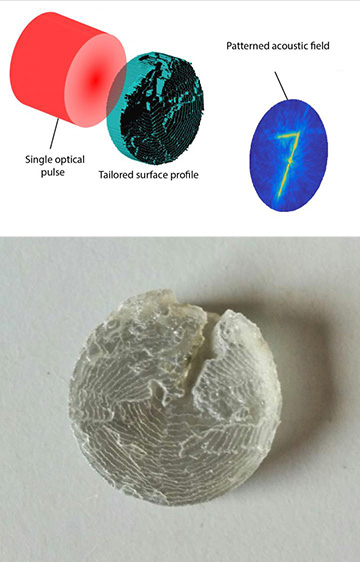
(Top) The UCL approach uses an optical pulse, impinging on a custom-designed, 3-D-printed surface, to produce a specific acoustic field (in this case, the number “7”). (Bottom) One of the team’s 3-D printed “photoacoustic lenses,” before it was spray-painted with optically absorbent material. [Images: M.D. Brown et al., Appl. Phys. Lett., doi: 10.1063/1.4976942]
Scientists at University College London (UCL), U.K., have developed a method for creating shaped ultrasound fields, with multiple, tightly focused maxima, without the use of acoustic transducers. Instead, the technique uses single, 6-nm-wide laser pulses, fired at custom 3-D printed shapes on which the team has spray-painted an optically absorbing material, to generate the patterned acoustic field (Appl. Phys. Lett., doi: 10.1063/1.4976942). The researchers believe that the technique—potentially far less expensive than custom arrays of acoustic transducers—could find use in a variety of physical and biomedical applications.
Getting sound into focus
In principle, the ability to create arbitrary sound fields—acoustic setups that produce multiple sound foci at specific spots, or custom-built continuous sound patterns—could prove quite handy, in applications ranging from manipulation of tiny particles and biological cell fragments in the lab to ultrasound therapy and neural stimulation in the clinic. But getting from principle to practice is the hard part.
Conventional ultrasound relies on piezoelectric transducers that convert electrical energy, sent through a material, into the high-frequency vibrational energy that yields the acoustic field. Getting a multifocus or shaped field out of such a setup would require complex arrays of transducers and electronics, a potentially expensive proposition.
A photoacoustic “lens”
The UCL team turned to light pulses to solve the problem. More specifically, they leveraged the photoacoustic effect, in which some of the energy from modulated light or a laser pulse, incident on the right material, is converted into sound. The researchers reasoned that, if the target of the laser pulse had the right shape, the resulting acoustic field could be customized to be focused at multiple points, creating tightly patterned ultrasound.
To start out, the researchers modeled a disk of target material as a series of individual pixels with a specific vertical dimension, and iteratively modeled the pixel heights that would be required to create a specific acoustic field from a laser pulse. The result is a sort of photoacoustic lens—a nubby, irregular surface that takes light as its input and produces sound, focused in a specific pattern. They then generalized the numerical model into an algorithm that would take as its input the user’s desired 3-D sound field, and generate as output a specific, 3-D-printable physical lens surface profile that would photoacoustically achieve that field.
A “7” in sound
From there, the team tested the algorithm by attempting to build a target surface profile that would create an acoustic field in the shape of the numeral “7” when the target was hit by a laser pulse. They used a high-resolution polyjet 3-D printer to create a rigid, nearly colorless photoacoustic lens in the computer-modeled shape, and spray-painted onto that material an optically absorbing polymer composite.
Then they suspended the lens at the top of a pool of water, and fired into the lens a 6-nm pulse from a Q-switched, 1064-nm YAG laser. The laser pulse photoacoustically generated sound from the target, the shape of which was transmitted through the water to a sensor at the bottom of the pool. The sensor revealed that the laser-generated acoustic field closely matched the modeled field—and the number “7” emerged, written in sound.
First author Michael Brown, a UCL Ph.D. student, notes that the technique needs refinement, particularly with respect to the light source used. For example, he suggests that a modulated optical source, rather than a pulsed laser, might help to refine the acoustic fields that can be created. But he sees substantial promise for practical applications, particularly in controlling and manipulating biological cells and other particles. “Similar single-focus devices are already being used for cleaving cell clusters and targeted drug delivery,” Brown says, “so our work could be useful within that area.”
